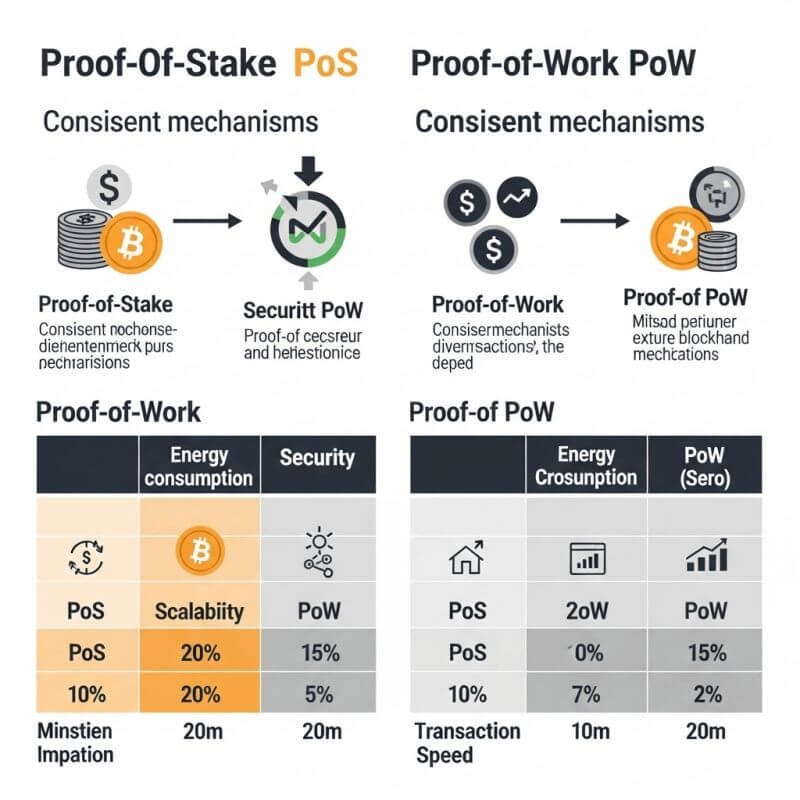
PoS and PoW: The Ultimate Guide to Thriving with Proof-of-Stake and Proof-of-Work
This analysis critically compares (PoS and PoW) Proof-of-Stake (PoS) and Proof-of-Work (PoW) within a single blockchain context. Discover their core differences, strengths, and weaknesses to understand their impact on performance and optimization.
PoS & PoW Decoded: Understanding Blockchain’s Foundation
To fully grasp the concept of staking, it is essential to understand PoS and PoW, two major blockchain consensus mechanisms that determine how transactions are validated.
PoS and PoW operate fundamentally differently—PoS selects validators based on the amount of cryptocurrency they stake in the network, while PoW requires miners to solve complex mathematical puzzles using high computational power.
By comparing PoS and PoW, investors and blockchain participants can better understand the efficiency, decentralization, and sustainability advantages that PoS offers over the energy-intensive nature of PoW mining.
The consensus mechanism of a blockchain network serves as its foundation, ensuring security, efficiency, and governance while maintaining decentralized control and trust.
Proof-of-Work (PoW) and Proof-of-Stake (PoS) are two fundamental consensus mechanisms that govern blockchain networks, each bringing unique benefits and challenges to security, decentralization, and efficiency.
PoW relies on miners competing to solve complex mathematical puzzles, requiring substantial computational power and energy consumption, which has raised concerns about its environmental impact. In contrast, PoS selects validators based on the amount of cryptocurrency they stake, drastically reducing energy usage while promoting a more accessible and sustainable validation process.
PoS and PoW differ not only in their energy requirements but also in their approach to network security and decentralization. PoW ensures security through the computational difficulty of mining, making attacks costly and impractical, whereas PoS deters malicious behavior by financially penalizing validators who act dishonestly.
PoS and PoW both play crucial roles in shaping the blockchain ecosystem, with PoS gaining popularity due to its efficiency and scalability, while PoW remains dominant in securing the most established cryptocurrencies like Bitcoin.
Understanding their differences is vital for grasping the significance of staking, which plays a key role in PoS-based blockchain ecosystems worldwide.
PoW, famously used by Bitcoin, operates through computational difficulty, requiring miners to solve complex mathematical puzzles using specialized high-performance hardware machines.
Miners compete to find solutions, broadcasting them to the network for verification, after which a new transaction block is securely added.
Mining demands immense computational power and energy, making it resource-intensive but ensuring robust security by discouraging malicious manipulation through economic and technical constraints.
Successful miners receive block rewards, including newly minted cryptocurrency and transaction fees, incentivizing continued participation and securing the blockchain through sustained competition.
PoW networks resist attacks due to their immense hashing power requirements, making large-scale manipulation impractical in well-established decentralized cryptocurrency ecosystems.
Despite its security benefits, PoW’s excessive energy consumption has raised concerns, leading to the exploration and adoption of Proof-of-Stake alternatives.
PoS and PoW are two distinct blockchain consensus mechanisms, each with its own approach to securing transactions and maintaining network integrity.
While PoS mechanisms rely on users holding and staking assets to validate transactions, PoS and PoW differ significantly in energy consumption and accessibility.
PoW—used by Bitcoin—requires miners to solve complex computational puzzles, making security dependent on high computational power, whereas PoS and PoW both aim to ensure blockchain security but through vastly different validation processes.
Stake Your Claim: The Energy-Efficient Future of Blockchain
- In stark contrast to PoW’s energy-intensive nature, Proof-of-Stake operates on the principle of ownership rather than computational power usage.
- PoS systems select validators to create new blocks and validate transactions based on the amount of cryptocurrency they stake in the network.
- The more cryptocurrency a user stakes, the higher their chances of being chosen as a validator for blockchain transaction verification.
- Different PoS protocols employ variations in selection, such as random selection weighted by stake size or stake duration considerations.
- When a validator proposes a new block, attestors can verify its validity, ensuring accurate transactions within the blockchain ecosystem.
- If a sufficient number of attestors agree, the block is added, rewarding both the proposer and attestors with transaction fees.
- PoS offers significantly lower energy consumption compared to PoW since it eliminates the necessity for energy-intensive mining hardware investments.
- Additionally, PoS can lead to faster transaction finality by streamlining the block creation and validation process efficiently.
- PoS network security relies on economic disincentives preventing validators from engaging in malicious activity that could compromise the blockchain’s integrity.
- If a validator validates fraudulent transactions, their staked assets can be slashed or confiscated as a penalty by the network.
- This economic risk structure ensures that validators are incentivized to maintain the integrity and security of the blockchain system effectively.
- The PoS model enhances energy efficiency, speeds up transactions, and reduces the environmental impact compared to PoW.
The Eco-Evolution: PoS Reshaping Blockchain’s Future
- The shift from PoW to PoS marks a major evolution in blockchain technology, aiming for greater sustainability and improved efficiency overall.
- PoW networks consume vast amounts of energy, leading to ongoing debates regarding their environmental impact and long-term viability in blockchain systems.
- Mining operations in PoW require significant electricity, raising concerns about their sustainability compared to newer PoS-based cryptocurrency validation methods.
- PoS eliminates competitive mining by selecting validators based on stakes, thereby reducing excessive energy consumption and resource-intensive computations.
- Validators in PoS do not rely on complex computations, drastically minimizing the energy footprint compared to traditional PoW mining processes.
- Lower energy consumption makes PoS an environmentally friendly alternative, addressing major concerns associated with PoW’s electricity-dependent mining model.
- PoS also enables faster transaction speeds, enhancing efficiency compared to PoW, which often suffers from longer block confirmation times.
- Some PoS implementations streamline block creation, making validation significantly quicker than the average processing time seen in PoW systems.
- Faster transaction confirmations in PoS result in a more responsive network, improving overall blockchain performance and user experience.
- The reduced computational demands of PoS lower barriers for participation, unlike PoW, which requires costly and specialized mining hardware investments.
- In PoW, high-performance mining rigs are essential, while PoS allows anyone with cryptocurrency stakes to validate transactions using standard equipment.
- PoS fosters greater decentralization, encouraging broader participation in securing the blockchain without needing expensive hardware like in PoW systems.
- The transition of major cryptocurrencies to PoS underscores the increasing recognition of its advantages in scalability, efficiency, and long-term sustainability.
Staking has gained significant traction, especially with newer cryptocurrencies and those transitioning from legacy models, as it promotes decentralization while enabling investors to maximize returns through long-term holdings.
Stake & Earn: Unlock Passive Crypto Income
- The rise of PoS consensus mechanisms has fueled crypto staking’s popularity, offering investors a new way to generate passive income efficiently.
- Unlike PoW mining, staking allows users to lock assets and earn rewards proportional to both stake size and duration.
- Long-term cryptocurrency holders find PoS staking attractive, believing in the future potential of their investments while earning additional rewards.
- Rather than leaving assets idle, staking engages crypto holders by securing the network and enabling them to earn valuable incentives.
- PoS plays a vital role in decentralization, ensuring a broader validator base compared to PoW’s concentrated mining operations.
- Unlike PoW, where mining pools dominate, PoS staking distributes validation power across a more diverse network, strengthening its resilience.
- Enhanced decentralization in PoS mitigates risks like censorship and single points of failure, improving blockchain security and accessibility.
- Decentralized finance (DeFi) has accelerated staking’s appeal, integrating mechanisms that let users earn rewards while engaging in financial applications.
- The synergy between staking and DeFi unlocks new earning opportunities, expanding yield possibilities for cryptocurrency investors.
- The transition of major cryptocurrencies toward PoS—like Ethereum’s adoption—has propelled staking into mainstream recognition and broader accessibility.
- Compared to PoW, PoS allows easier participation, welcoming a wider audience into blockchain security and validation processes.
- PoS staking maximizes returns for long-term holders while reinforcing blockchain security, shaping cryptocurrency’s evolving landscape.
Whether you’re a newcomer or an experienced investor, crypto staking presents an exciting opportunity to earn rewards while actively participating in the growing blockchain ecosystem.
Beyond HODLing: Staking – The Future of Crypto Earnings

Beyond simply holding (HODLing), discover crypto staking! Unlock passive income by participating in network validation. Explore the future of crypto earnings through staking.
- PoS staking offers a simple way for crypto newcomers to earn rewards beyond price appreciation, making blockchain participation more accessible.
- Unlike the complexities of PoW mining, PoS staking involves locking up crypto assets through a wallet or a staking platform.
- This allows users to contribute to the blockchain while earning passive income without needing technical expertise or active trading involvement.
- For seasoned investors, PoS staking is a valuable strategy to generate yield and potentially outperform simply holding cryptocurrency assets.
- Rewards earned through PoS staking can significantly boost investment returns, offering a compelling alternative to traditional PoW mining incentives.
- Participating in PoS staking lets investors actively contribute to network security and governance, strengthening blockchain decentralization.
- By locking up assets in PoS systems, users enhance network resilience, unlike the centralized nature of large-scale PoW mining operations.
- The rise of staking services on exchanges and dedicated platforms has made PoS participation easier for individuals seeking blockchain engagement.
- These platforms offer user-friendly tools, simplifying PoS staking for both beginners and experienced cryptocurrency investors alike.
- Research is critical before staking, as factors like lock-up periods, slashing risks, and platform reputation impact PoS investment decisions.
- Despite risks, PoS staking remains an attractive way to earn rewards, support decentralized networks, and shape the future of finance.
- The ongoing evolution of PoS mechanisms and increasing adoption suggest its influence on the crypto ecosystem will continue growing.